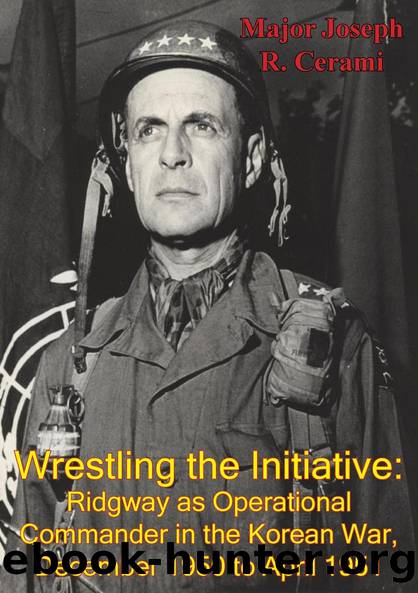Wrestling The Initiative: Ridgway As Operational Commander In The Korean War, December 1950 To April 1951 by Major Joseph R. Cerami

Author:Major Joseph R. Cerami [Cerami, Major Joseph R.]
Language: eng
Format: epub
Tags: History, Military, Korean War, Asia, India & South Asia, Korea, Central Asia
ISBN: 9781782899136
Google: laBvCwAAQBAJ
Publisher: Pickle Partners Publishing
Published: 2014-08-15T05:03:02+00:00
Phase IIâ Eighth Armyâs Defensiveâ Ridgway Takes Charge
The situation facing the Eighth Army in December of 1950 was serious but not desperate. The UN forces had gone beyond their culminating point in their advance towards the Yalu on two separate lines of operations. In facing the Chinese offensive, the Eighth Army, under General Walker, and the separate X Corps, under Major General Almond, were unable to set up effective defenses and were forced to retreat. In parallel, if not coordinated, actions the South Korean forces also began their withdrawal.
Of the difficult situation facing Ridgway, Fehrenbach writes:
âBut over a defeatedâeven though not shatteredâarmy lies a grayness of spirit. A retreat, once started, is the most difficult of all human actions to reverse....The grayness spread upward, to staffs and even to commanders. Men who had burned their fingers were now wary of the flame.â{63}
The Eighth Army had suffered a series of setbacks in the north. The 2d infantry Division had been overrun and driven through a devastating gauntlet.{64} The Indian Head Division would have to be reconstituted from top to bottom before it could re-enter combat as an effective fighting formation. In the eastern sector the 1st Marine Division had suffered, but it had added a heroic chapter to the Corpsâ history in its retreat from the Chosin Reservoir. The action of the US 7th infantry Division has been described as a routâespecially in light of the tragic fate of Task Force Faith, a brave team of soldiers, sent on an ill-conceived operation and then abandoned in the snows east of Chosin.{65}
Yet, despite these serious setbacks, the Eighth Army had net been destroyed. Although disorganized and withdrawing in great haste, the Eighth Armyâs situation was far from hopeless. Ridgway sized-up the posture of his army relatively quickly. It was not the first time he had seen an American Army in a chaotic withdrawal. As commander of the 18th Airborne Corps he had participated in the Ardennes during the Battle of the Bulge. At that time he had also rushed to the front, stopped retreating soldiers, and set units into a hasty defensive.{66} He would be conducting a similar operation during his first days in the Korean theater.
Right off the bat Ridgway was concerned with the state of his combined army, especially the morale of the South Koreans. In country, after making a quick aerial reconnaissance of the in hospitable terrain, he visited President Rhee.{67} After assuring Rhee of the strong US resolve to stay and fight in Korea, Ridgway inspected the front for three days.
Overall, his assessment was that Eighth Army lacked an offensive, fighting spirit. He observed that the US forces lacked the aggressiveness and alertness of the army he had known in Europe in World War II.{68} As Fehrenbach has recorded, Ridgway also noticed the grayness covering the Army from the highest levels on down to the individual soldiers. The new commanderâs first impression was decidedly unfavorable, starting from the moment he discovered that the majority of his headquarters staff was located in Taegu, two hundred miles to the rear of the frontlines.
Download
This site does not store any files on its server. We only index and link to content provided by other sites. Please contact the content providers to delete copyright contents if any and email us, we'll remove relevant links or contents immediately.
| Central Asia | Southeast Asia |
| China | Hong Kong |
| India | Japan |
| Korea | Pakistan |
| Philippines | Russia |
The Sympathizer by Viet Thanh Nguyen(4339)
The Rape of Nanking by Iris Chang(4166)
World without end by Ken Follett(3445)
Ants Among Elephants by Sujatha Gidla(3440)
Blood and Sand by Alex Von Tunzelmann(3164)
Japanese Design by Patricia J. Graham(3138)
The Queen of Nothing by Holly Black(2541)
City of Djinns: a year in Delhi by William Dalrymple(2531)
Foreign Devils on the Silk Road: The Search for the Lost Treasures of Central Asia by Peter Hopkirk(2442)
India's Ancient Past by R.S. Sharma(2432)
Inglorious Empire by Shashi Tharoor(2411)
Tokyo by Rob Goss(2405)
In Order to Live: A North Korean Girl's Journey to Freedom by Yeonmi Park(2359)
Tokyo Geek's Guide: Manga, Anime, Gaming, Cosplay, Toys, Idols & More - The Ultimate Guide to Japan's Otaku Culture by Simone Gianni(2344)
India's biggest cover-up by Dhar Anuj(2333)
The Great Game: On Secret Service in High Asia by Peter Hopkirk(2314)
Goodbye Madame Butterfly(2226)
Batik by Rudolf Smend(2151)
Living Silence in Burma by Christina Fink(2047)
